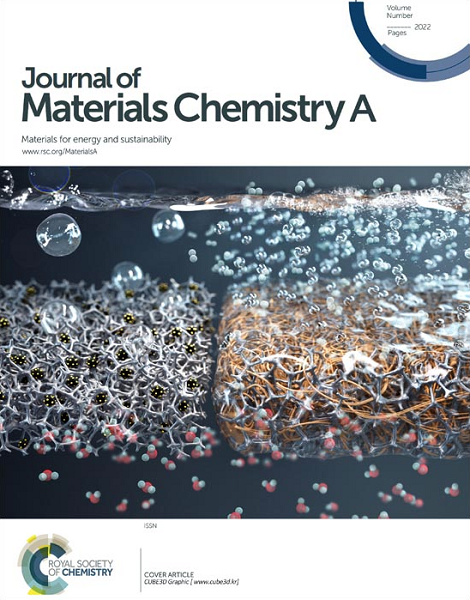基于碳量子点的混合基质膜具有增强的CO2捕获性能
IF 9.5
2区 材料科学
Q1 CHEMISTRY, PHYSICAL
引用次数: 0
摘要
摘要混合基质膜结合了有机膜和无机膜的互补优势,可以更容易地超越Robeson上界。然而,这些膜不可避免地会受到纳米颗粒团聚和由此产生的非选择性界面缺陷的影响,这大大降低了它们的二氧化碳(CO2)分离性能。此外,粒子聚集对制备薄膜纳米复合材料(TFN)膜提出了相当大的挑战。本研究通过一步法合成了富含氨基和含氧官能团的CQDs,并将其用于制备用于CO2分离的MMMs。0D碳量子点(CQDs)的小尺寸使其在铸造溶液中分散均匀,有效防止填料聚集导致的CO2分离性能下降。同时,CQDs的加入改变了Pebax 1657的无序性和亲水性,显著提高了其CO2捕集性能。在进料压力为6 bar时,CQDs-Pebax 1657膜的CO2渗透率达到248.3 Barrer, CO2/N2选择性为78.1(接近2019 Robeson上限)。TFN膜的CO2透过率为248.4 GPU, CO2/N2分离系数为56.2。在100%相对湿度条件下,CO2透过率提高到345.9 GPU, CO2/N2分离因子为64.2,优于大多数pebax基膜。在72 h的连续测试中,所获得的膜也表现出良好的稳定性,表明CQDs可以被认为是一种理想的纳米添加剂,可以有效地提高膜的CO2捕获渗透率。本文章由计算机程序翻译,如有差异,请以英文原文为准。
Mixed matrix membranes based on carbon quantum dots with enhanced CO2 capture performances
Abstract Mixed matrix membranes (MMMs) can more readily surpass the Robeson upper bound by combining the complementary advantages of organic and inorganic membranes. However, these membranes inevitably suffer from nanoparticle agglomeration and the resulting non-selective interfacial defects, which significantly deteriorate their carbon dioxide (CO2) separation performance. Furthermore, particle aggregation poses considerable challenges for fabricating thin-film nanocomposite (TFN) membranes. In this study, CQDs rich in amino and oxygen-containing functional groups were synthesized via a one-step method and used to fabricate MMMs for CO2 separation. The small size of 0D carbon quantum dots (CQDs) enables their uniform dispersion in casting solutions, effectively preventing filler aggregation-induced degradation of CO2 separation performance. Meanwhile, the addition of CQDs altered the disorder and hydrophilicity of Pebax 1657, significantly improving its CO2 capture performance. With a feed pressure of 6 bar, the CO2 permeability of the CQDs-Pebax 1657 membrane reached 248.3 Barrer, with a CO2/N2 selectivity of 78.1 (close to the 2019 Robeson upper bound). TFN membranes have been also developed, CO2 permeance of 248.4 GPU and CO2/N2 separation factor of 56.2 was documented. Under 100% relative humidity conditions, the CO2 permeance was improved to 345.9 GPU, and the CO2/N2 separation factor was 64.2, outperforming most other Pebax-based membranes. The obtained membranes also exhibited good stability performances in a 72 h of continuous test, denoting that CQDs can be considered an ideal nano additives to effectively enhance membrane CO2 capture permeances.
求助全文
通过发布文献求助,成功后即可免费获取论文全文。
去求助
来源期刊

Journal of Materials Chemistry A
CHEMISTRY, PHYSICAL-ENERGY & FUELS
CiteScore
19.50
自引率
5.00%
发文量
1892
审稿时长
1.5 months
期刊介绍:
The Journal of Materials Chemistry A, B & C covers a wide range of high-quality studies in the field of materials chemistry, with each section focusing on specific applications of the materials studied. Journal of Materials Chemistry A emphasizes applications in energy and sustainability, including topics such as artificial photosynthesis, batteries, and fuel cells. Journal of Materials Chemistry B focuses on applications in biology and medicine, while Journal of Materials Chemistry C covers applications in optical, magnetic, and electronic devices. Example topic areas within the scope of Journal of Materials Chemistry A include catalysis, green/sustainable materials, sensors, and water treatment, among others.
 求助内容:
求助内容: 应助结果提醒方式:
应助结果提醒方式:


